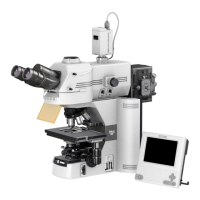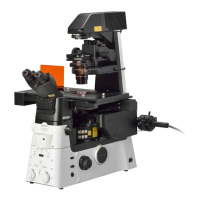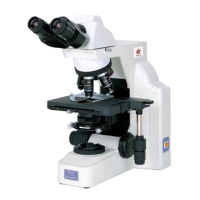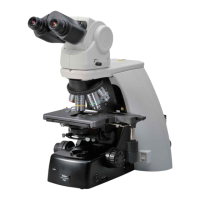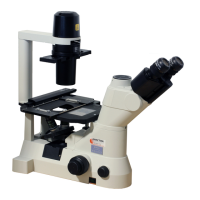Chapter 3 Individual Operations
3.16 Polarization Microscopy
49
3.16.5
P-CL 1/4λ & Tint Plate
The intermediate tube has a slot for the P-CL 1/4λ & tint plate. It is used not only for the plate
but also for the optional P-CS Senarmont compensator or P-CQ quartz wedge to perform the
retardation measurement.
To use an objective of 10X or higher magnification in standard observation, place the top
lens of the P swing-out condenser into the optical path or pull out the slider of the slide
condenser.
To perform the retardation measurement or to perform evaluation by interference color, the
illumination light must be as parallel to the optical axis as possible. So, the condenser
aperture diaphragm must be stopped down or the top lens of the P swing-out condenser
must be swung out (the aperture diaphragm is fully opened) even if an objective of 10X or
higher is used.
P-CL 1/4λ & tint plate
The P-CL 1/4λ & tint plate has an empty hole in the
center. By pushing it into the slot, the sensitive
color plate (530 nm) is brought into the optical
path. Pulling it out brings the 1/4λ plate into the
optical path.
This plate is used for recognition of very weak
birefringence and the determination of X' and Z' of
the specimen.You can measure retardation of light
up to 1λ with the following steps.
P-CS Senarmont compensator
Remove the P-CL 1/4λ & tint plate from the slot of
the intermediated tube and insert the P-CS
Senarmont compensator into the slot.
You can measure retardation of light up to 1λ with
the following steps.
1 Determination of extinction position
Rotate the stage with the specimen under the crossed Nicols to find the direction where the
part of the specimen to be measured appears darkest.
2 Determination of subtraction position
Rotate the stage 45° from the extinction position to the diagonal position. If the interference
color changes toward the higher order side, rotate the stage another 90°.
3 Measurement
Place the GIF filter on the field lens and replace the P-CL 1/4λ & tint plate with the P-CS
Sénarmont compensator. Rotate the analyzer so that the section of the specimen to be
measured becomes darkest. When the rotation angle of the analyzer at that time is taken to
be theta (θ) degrees, then retardation (R) (nm) is determined with the following formula:
The value of λ when using the GIF filter is 546 nm.
R =
θ
λ(λ: wavelength)
180
P-CL 1/4 λ &
tint plate
P-CS senarmont compensator

